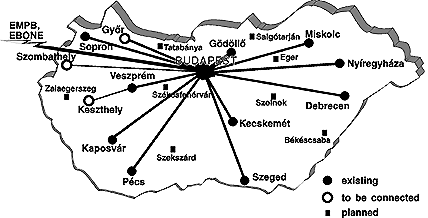
Hungarian Internet backbone infrastructure

by Otto Hutter
In this article we give a short overview about the Hungarian Internet backbone infrastructure, which is used by the research/educational sphere. Nowadays, the commercial users give very small part of the Hungarian Internet community, so we do not deal with commercial Internet service providers, who are setting up their separate infrastructure. The article is a summary of presentations delivered by Balazs Martos (MTA SZTAKI) and Laszlo Csaba (Hungaria Szamitastechnika Kft.), project managers of the central Hungarian Internet programs, at recent networking conferences.
The Internet today is a superset of nearly 40.000 TCP/IP networks, which links about 4 million computers all around the World. The exponential growth of the system enforces radical changes regarding to the services and the operation. The role of the multimedia, picture-oriented services is growing very fast. The biggest part of the Internet traffic comes already from the World Wide Web applications, but multimedia e-mail and video conferences are also more and more important.
It is getting more and more difficult to finance the maintenance of the international backbone networks or instance the US Internet backbone, the NSFNet was sponsored by the government till April of 1995, but then it has been taken over by commercial service providers. Now the centre of the world-wide Internet network is in Washington, where the US and European Internet providers are connected to each others, through the Commercial Internet Exchange (CIX). It is difficult to predict how it will affect the Hungarian Internet users in the future, but it is sure that at this moment the far biggest part of them is connected to the HBONE. HBONE, the Hungarian Internet backbone is maintained by the National Information Infrastructure (NIIF) program sponsored by the Hungarian Academy of Sciences, Ministry of Education, National Committee of Technological Development and Hungarian Scientific Research Fund. The program, which has just been prolonged for the next three years, now concentrates on the academic/university sphere, but the program is just being extended to cover the secondary schools and partly the non- IIF users, as well.

The most important European backbones for the Hungarian Internet users are the EuropaNet and EBONE II. The EuropaNet is a multi-protocol backbone operated by British Telecom. There are 36 organisations from 17 countries connected to EuropaNet through routers with 64 kbps-2 Mbps speed. Since 1994 November, Hungary has had a 128 kbps (Hungarnet) and a 64 kbps (Technical University of Budapest) interface to EuropaNet, but it is upgraded to 2 Mbps from 1995 September. The EBONE II network is based on a 2 Mbps Paris-Vienna backbone line, and the other networks are connected to the endpoints. The whole EBONE is connected to the mentioned Washington based CIX with a high, 5 Mbps bandwidth. Till this February, the Hungarian IP network had two 64 kbps connection to the EBONE, and the speed has been increased to 256 kbps since then.
Hungarian IP backbone
The construction of the Hungarian IP network started in 1993, and it connects the LANs of the IIF institutes and the campus networks in different towns. The whole network is based on the public digital leased line service of MATAV (Hungarian Telecom), with the typical speed of 64 kbps. The public X.25 network is used as a backup system. As it is shown in Fig. 1, the HBONE has a star topology, with a centre in Budapest. There are five regional HBONE nodes in Budapest (MTA SZTAKI, BME, BKE, ELTE, KFKI), which are connected through a double FDDI ring, fibre optic Ethernet, and a 2 Mbps micro- wave segment.
The HBONE system is operated by the NIIF program. The program has purchased the routers in the regional nodes, pays for the leased lines between them, pays of the expenses of the international connections. It even covers the cost of the X.25 or leased lines of the IIF member institutes. The non-IIF companies are also allowed to use the HBONE infrastructure, but they have to pay the costs of the data transfers up to the nearest HBONE node and they have to buy the equipment for the connection.
The development of HBONE will continue in the next years, with the continuous support of the NIIF program. The two main directions of the developments connect every county seat (about 20 towns) and the design of the next generation of the HBONE network, supporting the emerging communication technologies, like Frame Relay, ATM and ISDN.